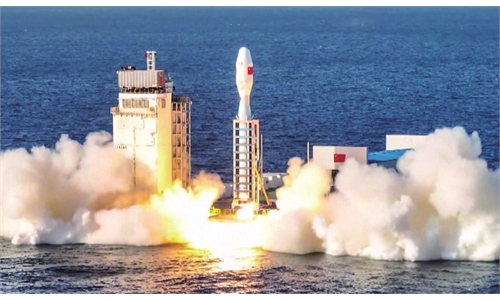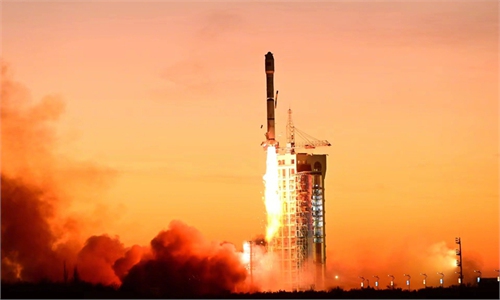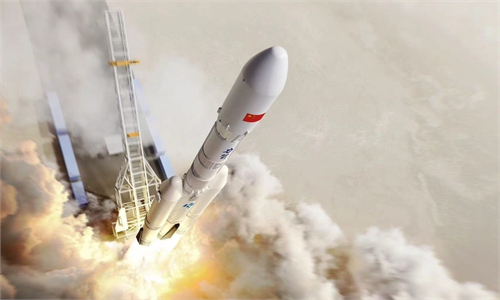China’s commercial space companies compete to reduce rocket cost, enhance performance

A Gravity-1 (YL-1) commercial carrier rocket carrying three satellites takes off from waters off the coast of Haiyang, East China's Shandong Province, on January 11, 2024. The satellites were successfully placed into a planned orbit. Photo: VCG
On January 11, a flash of fire appeared in the distance over the southern sea of the Haiyang spaceport, in East China's Shandong Province. It was the world' s mightiest solid carrier rocket, the Gravity-1, making its grand debut, which marked the beginning of a busy and exciting year for China's commercial space industry, with multiple highlights and breakthroughs to be expected.
With the massive demand brought by the scale deployment of China's internet satellite mega constellation, China's commercial space industry is experiencing unprecedented development. Unlike SpaceX which has an absolute dominance in the US market, China has seen a flourishing trend in private ventures, which can fully stimulate market competition and drive technological revolution, industry insiders say.
Gravity-1, as the first launch of a commercial rocket this year and a new type of rocket making its maiden flight, has dazzled the world not only by its plump design but also an array of remarkable distinctions - the largest, heaviest, first of its kind and unprecedented. But this is just the beginning of China's space endeavors in 2024. The year 2024 will be extremely busy with many exciting highlights, among which commercial spaceflight will play a crucial part.
The Global Times learned from Orienspace, the Gravity-1's developer, that the rocket has surpassed the European Vega-C rocket to become the largest solid-fueled orbital launch vehicle in history, with a takeoff weight of 405 tons and a thrust of 600 tons. It has a payload capacity of 6.5 tons to Low Earth Orbit (LEO) and 4.2 tons to Sun-Synchronous Orbit (SSO), making it capable of supporting the launch of 30 kilogram-class satellites in one go.
In addition to the successful debut of Gravity-1, 2024 is expected to see a record-breaking number of maiden flights, according to open data. Among the seven currently known debut rockets, five of them are private commercial rockets, including the Tianlong-3 reusable liquid rocket with performance benchmarked against SpaceX Falcon 9; the Nebula-1 reusable orbital rocket; and the SQX-2 offshore recovery validation rocket.
In addition to the maiden flights, the launch frequency of current commercial rockets in China's private space sector is also expecting a surge, with the total number of launches scheduled to exceed 20.
Homemade techs
The Beijing start-up iSpace, developer of the SQX series of rockets that made the country's first successful recovery of a liquid oxygen methane-propelled rocket, told the Global Times that although some Western media has labeled them as "China's SpaceX" for studying reusable launchers, iSpace is essentially based on domestic aerospace technologies.
It means that each major system of the rocket is independently developed, and all key technologies are tackled independently. For example, iSpace has independently developed the JD-1 liquid oxygen-methane engine, while the Falcon-9 uses Merlin engines. In comparison, the JD-1 offers superior reusability performance and lower cost.
For the next step, the company told the Global Times that the R&D of the SQX-3 large reusable launch vehicle is underway, with the aim of conducting its maiden flight by the end of 2025. With a diameter of 4.2 meters and a total length of 70 meters, it is expected to achieve a payload capacity of 12.9 tons to a 200 kilometer low Earth orbit, comparable to the Long March-7 carrier rocket.
Once put into use, the SQX-3 will be ready for key launch missions such as satellite constellation deployment and space station cargo resupply, while significantly reducing the cost of China's access to space.
Another private venture, Deep Blue Aerospace, which eyes to launch the Nebula-1 reusable orbital rocket this year after having completed milestone kilometer-level recovery test, told the Global Times that independence and the peaceful utilization of space resources have always been China's policy that represents a solemn commitment to the world, and this overarching theme is what all private space practitioners strive for.
"The development of China's commercial space industry has benefited from the excellent foundation built over the past decades through our independent advancements in the aerospace sector," the company said in a statement sent to the Global Times. "Multiple favorable factors such as national strategy and policies have propelled the rapid growth of commercial space enterprises."
Deep Blue Aerospace has developed a 3D-printing additive manufacturing technology, which enabled the rapid production for liquid rocket engines. The use of 3D printing technology, replacing the traditional process, has reduced the manufacturing cycle for reinforcement ribs by 75 percent, increased the qualification rate to 98 percent and lowered costs by 30 percent.
In commercial space sector and other fields, such as high-speed rail, nuclear power, photovoltaic, wind energy and new energy vehicles, China's model of government-led policies, government investment (or subsidies) creating demand, and fair competition among enterprises has repeatedly proven successful, Chinese space observers noted.




